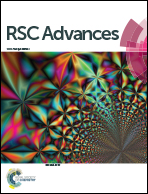Fabrication of a multifunctional nanocomposite containing INP coated with chitosan coupled with folic acid and loaded with quercetin in diagnosis and its possible treatment of cancer
Abstract
Quercetin is one of the most prevalent as well as thoroughly studied dietary flavonoids with several biological and anticancer properties. However, its low bioavailability and poor solubility in aqueous medium (∼2%) are major concerns associated with the therapeutic application of quercetin. Therefore, the present work is aimed at designing a nanocomposite that will be nontoxic, cost effective and enhance the increased solubility of the drug quercetin that possess anticancer properties. The multifunctional nanocomposite was developed using iron oxide nanoparticles (INP) extracted and synthesized from magnetite sand and further fabricated using chitosan, folic acid and finally loaded with aqueous poorly soluble quercetin. The developed nanocomposite was characterized for its physicochemical properties. To confirm the anticancer properties, the nanocomposite was treated with two different cell lines and assessed by flow cytometry and by ethidium bromide acridine orange staining to detect the apoptotic and necrotic cells respectively. The nanoparticles were crystalline in nature with average size distribution values of 17.58 d nm and 42.7 d nm for INPs and Q-INP-CF respectively. Moreover, vibrating sample magnetometer (VSM) and Magnetic Resonance Imaging (MRI) results revealed the magnetic properties of Q-INP-CF. Q-INP-CF induced apoptosis in both PC-3 and MCF-7 as observed using flow cytometry and by ethidium bromide acridine orange staining. The prepared Q-INP-CF can be effectively used as a novel and cheaper MRI contrast agent with MRI sensitivity which will be helpful in both diagnosis and eradicating cancer cells.


 Please wait while we load your content...
Please wait while we load your content...